Mecha: A Neural-Symbolic Open-Set Homogeneous Decision Fusion Approach for Zero-Day Malware Similarity Detection
IF 5.6
1区 计算机科学
Q1 COMPUTER SCIENCE, SOFTWARE ENGINEERING
引用次数: 0
Abstract
With increasing numbers of novel malware each year, tools are required for efficient and accurate variant matching under the same family, for the purpose of effective proactive threat detection, retro-hunting, and attack campaign tracking. All of the state-of-the-art Deep Learning (DL) approaches assume that the incoming samples originate from known families and incorrectly identify novel families. Additionally, most of the existing solutions that leverage the Siamese Neural Network architecture either rely on pair-wise comparisons or computationally expensive preprocessing steps that are not scalable to a real-world malware triage volume requirement. We propose a different route, Mecha, a Neural-Symbolic Machine Learning (ML) system for malware variant matching and zero-day family detection. Mecha is comprised of an embedding network trained in two different scenarios for byte string embedding and an open-set approximate nearest neighbour algorithm for variant matching and zero-day detection. Our embedding network uses triplet loss for embedding generation and reinforcement-based Expectation Maximization (EM) learning for full deployment optimization. We conduct multiple in-sample and out-of-sample experiments to demonstrate the model's generalizability toward novel variants and families. We also show that Mecha can detect samples outside the known set of malware samples with an accuracy greater than 0.990.机制:一种用于零日恶意软件相似度检测的神经符号开集同构决策融合方法
随着每年新型恶意软件数量的不断增加,为了有效地进行主动威胁检测、回溯狩猎和攻击活动跟踪,需要在同一家族下进行高效、准确的变体匹配的工具。所有最先进的深度学习(DL)方法都假设传入的样本来自已知的家族,并且错误地识别了新的家族。此外,大多数利用Siamese神经网络架构的现有解决方案要么依赖于成对比较,要么依赖于计算成本高昂的预处理步骤,这些步骤无法扩展到现实世界的恶意软件分类容量需求。我们提出了一个不同的路线,Mecha,一个用于恶意软件变体匹配和零日家族检测的神经符号机器学习(ML)系统。Mecha包括在两种不同场景下训练的嵌入网络,用于字节串嵌入,以及用于变量匹配和零日检测的开集近似近邻算法。我们的嵌入网络使用三重损失进行嵌入生成,并使用基于强化的期望最大化(EM)学习进行全面部署优化。我们进行了多个样本内和样本外实验,以证明该模型对新变体和家族的可泛化性。我们还表明,Mecha可以检测已知恶意软件样本集之外的样本,准确率大于0.990。
本文章由计算机程序翻译,如有差异,请以英文原文为准。
求助全文
约1分钟内获得全文
求助全文
来源期刊

IEEE Transactions on Software Engineering
工程技术-工程:电子与电气
CiteScore
9.70
自引率
10.80%
发文量
724
审稿时长
6 months
期刊介绍:
IEEE Transactions on Software Engineering seeks contributions comprising well-defined theoretical results and empirical studies with potential impacts on software construction, analysis, or management. The scope of this Transactions extends from fundamental mechanisms to the development of principles and their application in specific environments. Specific topic areas include:
a) Development and maintenance methods and models: Techniques and principles for specifying, designing, and implementing software systems, encompassing notations and process models.
b) Assessment methods: Software tests, validation, reliability models, test and diagnosis procedures, software redundancy, design for error control, and measurements and evaluation of process and product aspects.
c) Software project management: Productivity factors, cost models, schedule and organizational issues, and standards.
d) Tools and environments: Specific tools, integrated tool environments, associated architectures, databases, and parallel and distributed processing issues.
e) System issues: Hardware-software trade-offs.
f) State-of-the-art surveys: Syntheses and comprehensive reviews of the historical development within specific areas of interest.
 求助内容:
求助内容: 应助结果提醒方式:
应助结果提醒方式:


